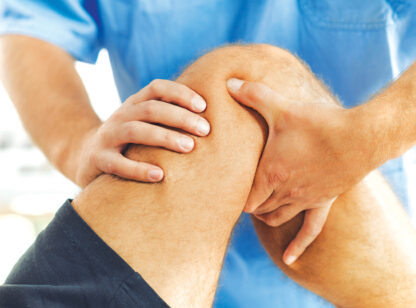Arthritis is an inflammation of the joints that can lead to debilitating pain. More than 100 kinds of arthritis and related conditions affect more than 50 million adults and 300,000 children in the U.S. While there is no cure, creating a holistic wellness plan is often the first line of defense in managing pain and achieving remission.
The type of arthritis you have will determine the treatment plan. The two most common are osteoarthritis (OA) and rheumatoid arthritis (RA). OA is known as the “wear and tear” disease. It usually begins in an isolated joint and occurs when the smooth cartilage of the joint surface wears out. RA is an autoimmune disease occurring when the immune system malfunctions and attacks the body, causing inflammation.
All types of arthritis can benefit significantly from simple lifestyle changes such as physical therapy, exercise and a healthy diet. Exercise is vital for RA and OA, but some exercises may be contraindicated while others are safe, depending on your diagnosis. The most important things to share with your physical therapist or personal trainer are what kind of arthritis you have and where it hurts.
With any exercise regime, speak with your doctor before you begin, start slowly and listen to your body. If you suffer from RA pain, first evaluate the location of the affected joints. If you don’t have damage to the weight-bearing joints, it should be safe to participate in high-intensity exercise such as aerobics or jogging. If you do have damage in the lower extremities, avoid high impact; if you suffer from knee pain, avoid deep squats or lunges (more than 90 degrees); if the damage is in your upper extremities, no boxing or heavy weightlifting.
If you have OA, movement is a vital ingredient to a non-drug therapy treatment plan. Your goal should be that recommended for healthy adults: 150 minutes of moderate-to-vigorous cardiovascular exercise per week.1 Walking and swimming are two of the safest and most effective modalities. The objective is to relieve OA pain and stiffness. The dichotomy is people who suffer from OA are sometimes in so much pain the last thing they want to do is exercise; however, it is the best medicine.
A comprehensive exercise program should include the following four pillars, and it is recommended that you start with a trained professional: 1) strength training exercises to build strength in the muscles around painful joints to reduce stress; 2) range of motion or stretching to ease stiffness and increase mobility, stamina and weight loss; 3) cardio for increased energy, stamina, and weight loss and 4) balance to prevent falls and strengthen small muscles around the joints such as knees and ankles.
“Exercise and physical therapy have lasting, long-term positive outcomes [for osteoarthritis],” says Bella Mehta, MD, a rheumatologist at Hospital for Special Surgery in New York City.2
In addition to your exercise program, it is important to maintain a healthy diet. According to the Arthritis Foundation, research shows that overweight people with arthritis who lose 10 percent of their weight have better mobility and 50 percent less pain.3
Obesity and inflammation are major considerations for arthritis pain, and while there is no miracle diet for arthritis, there are foods that can help fight inflammation and improve joint symptoms. A diet rich in fruits, vegetables, fish, nuts and beans, and low in processed foods and unhealthy fats can help manage disease activity. These are the primary principles of the Mediterranean diet which is recognized for both its anti-aging and disease-fighting powers.4
If you are sick and tired of being sick and tired, reach out for support. Often this is the first step to finding the discipline and strength to start to walk down your path to living pain-free!
Michele McCord is a certified personal trainer and yoga instructor, nutritional consultant and founder of the Michele McCord Method. She can be reached at (310) 923.3237 or me@michelemccordmethod.com. For more information, visit www.michelemccordmethod.com.
References: 1) U.S. Department of Health and Human Services; 2) www.arthritis.org/diseases/osteoarthritis; 3) www.arthritis.org/health-wellness/healthy-living/nutrition/weight-loss/8-ways-to-lose-weight-without-dieting; 4) https://www.arthritis.org/health-wellness/healthy-living/nutrition/anti-inflammatory/the-ultimate-arthritis-diet









































Comments (0)